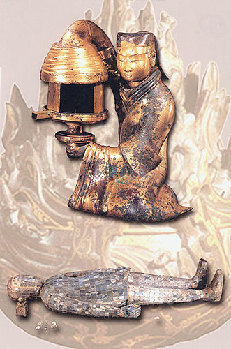Tomb of Prince Jing (named Liu Sheng) of Zhongshan and his wife Dou Wan
Location:Mancheng County,HebeiProvince
Period: 113 BC, 104 BC
Excavated in 1968
Significance: It has disclosed the structure of tombs and burial systems for princes in the theHan Dynasty (206BC-220AD).
|

|
| Gilded bronze "Eternal Fidelity Palace" lamp holding by a figurine of palace maid: lighting apparatus (up, height 48 cm); Jade clothes sewn with gold thread: burial suit (bottom, length 1.88 m); Boshan bronze incense burner inlaid with gold: incense burner (in the background, height 26 cm) |
 Introduction
Introduction
Tombs of Han at Mancheng are included in the list of the Top Ten Archaeological Discoveries inChinaduring the 20th century. They were built for the Zhongshan King Liu Sheng, a son of Emperor Jing Di, and his wife Dou Wan respectively. In 1968 the two tombs were found in present-dayManchengCountyinHebeiProvince. The tombs are the first undisturbed royal Western Han tombs ever discovered. Liusheng's Tomb is 52 meters long, 38 meters wide and 7 meters high. The structure and layout of the tombs departs from earlier traditions in significant ways.
The well-preserved tombs are large and the exact time of its construction has been accurately determined. The tombs contained over 2,700 burial objects. Among them, bronze and iron items predominate. Altogether there are 419 bronze objects, 499 iron objects, 21 gold items, 77 silver items, 78 jade objects, 70 lacquer objects, 6 chariots, 571 pieces of pottery and silk fabric.
Most of the funerary objects found in the tombs are unique, including two sets of complete jade clothes sewn with gold thread, a famous Changxin Palace Lantern, and a brilliant and delicate gold-inlaid furnace. All these objects demonstrate the advanced techniques of the Western Han Dynasty in handicrafts and arts and crafts.
